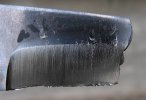- Joined
- Apr 2, 2017
- Messages
- 29
Your test has limitations. All are cutting a single soft item. If you try to cut soft items and hard items. You will find high hardness of the edge, it will easily collapse. If it is cutting leather, the hardness of a great impact, if cutting relatively hard items (such as ebony, PVC, hard plastic), high hardness and no advantage.

